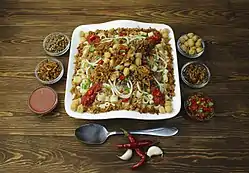Koshary
Koshary (Egyptian Arabic: كشري, [ˈkoʃæɾi]), also kushari and koshari, is Egypt's national dish and a widely popular street food.[1] An Egyptian dish that originated during the mid-19th century, the dish combines Italian, Indian and Middle Eastern culinary elements. Koshary is made of rice, macaroni, and lentils mixed together,[2] topped with a spiced tomato sauce and garlic vinegar and garnished with chickpeas and crispy fried onions. It is often served with sprinklings of garlic juice; garlic vinegar and hot sauce are optional.
 Koshary | |
| Type | Mixed-rice dish |
|---|---|
| Course | Main course |
| Place of origin | Egypt |
| Serving temperature | warm or hot |
| Main ingredients | rice, lentils, macaroni, tomato sauce, vegetable oil, onions, cumin, coriander |
| Variations | chickpeas, hot sauce, garlic juice, vinegar, short spaghetti |
| Similar dishes | Khichdi, Mujaddara |
Etymology and spelling
"Koshary" comes from a spelling variation of the Indian dish khichdi, as khichri. The most popular English spelling in Egypt is spelled as Koshary, other variations of the spelling are Kushari also Koshari, and Kosheri.
History
Koshary originated in the mid-19th century, during a time when Egypt was a multicultural country in the midst of an economic boom. It consists of fried onions, lentils, rice, macaroni and lemon sauce. It is somewhat related to Italian cuisine and to an Indian dish made only from rice and lentils, khichdi, but the Egyptian dish has more ingredients and flavors, especially the local Egyptian sauce giving it the unique taste the dish is popular for. Some believe it was first made during the period of British rule in Egypt, when Indians and Egyptians served as domestic servants in the houses of Britons living in the country. It is rumored that they used to boil leftovers from the dinner and that the Egyptians came up with the idea to add tomato sauce to the dish to add more flavor. Over time, the dish has evolved through Egyptian citizens, then Egyptian soldiers.[3] Koshary used to be sold on food carts in its early years, and was introduced to restaurants later.[4]
This dish is widely popular among workers and laborers and the dish is well-suited to mass catering events such as conferences. It may be prepared at home, and is also served at roadside stalls and restaurants all over Egypt; some restaurants specialize in koshary to the exclusion of other dishes, while others feature it as one item among many.[5] As traditionally prepared koshary does not contain any animal products, it can be considered vegan, as long as all frying uses vegetable oil.
Variants
The Alexandrian Koshary is very different from the known recipe as it changes visually and in taste, the process of cooking includes yellow lentils and rice, it also uses curry and cumin in the rice which makes them have a uniform color, it Includes Egyptian Rolled eggs as well which is boiled then fried eggs in ghee or butter, As well as lightly pickled Tomatoes instead of the sauce and French Fries on the side.[6]
The dish with the Koshary name has seen some popularity in other Arab countries in recent years, especially in the Persian Gulf region and Yemen, There's adjustments and changes based on each country or region, the variations include adding grilled vegetables and changing the rice type to Basmati cooked either white or yellow, recipes of that region uses other shapes of macaroni, the recipes could include chicken too which makes it close to Kabsa in some cases.[7]
The dish is served in Japanese carts and has some additions added on top of the original recipe, the additions are, basil chicken, raw tomatoes, sour cream, fried eggs, cheddar cheese sauce, avocado slices, and spicy powder with jalapeño.[8]
See also
References
- Galloway, Lindsey (13 January 2020). "Why 2020 is the year to visit Cairo". BBC Travel. Archived from the original on 2020-02-12.
- Yogerst, Joe (2020-01-15). "Food in Egypt: 13 delicious dishes and drinks you shouldn't miss". CNN. Retrieved 2020-09-14.
Koshary: One of Egypt's most popular dishes is a carb-packed combination of macaroni, rice and beans flavored with tomatoes, onions, garlic and whatever else the chef feels like tossing in.
- "yahoo- maktoob CNBC". Archived from the original on 2014-11-13. Retrieved 2014-11-13.
- Parvi, Shahrokh (6 March 2016). "Cheap, healthy and oh so tasty: the best kushari in Cairo". The Guardian. Archived from the original on 6 January 2018. Retrieved 8 October 2017.
- "Kushari recipe". Whats4eats.com. Archived from the original on 2013-01-28. Retrieved 2013-02-17.
- "كشري اسكندراني بالصور من Alaa Abbas". كوكباد (in Arabic). Archived from the original on 2020-07-26. Retrieved 2020-07-26.
- "كشري خليجي بالخضار والدجاج بالصور". forums.graaam.com. Archived from the original on 2020-07-26. Retrieved 2020-07-26.
- "エジプトめしコシャリ屋さん". koshary-yasan.hungry.jp. Archived from the original on 2020-07-26. Retrieved 2020-07-26.
External links
| Wikibooks Cookbook has a recipe/module on |
 Media related to Kushari at Wikimedia Commons
Media related to Kushari at Wikimedia Commons
